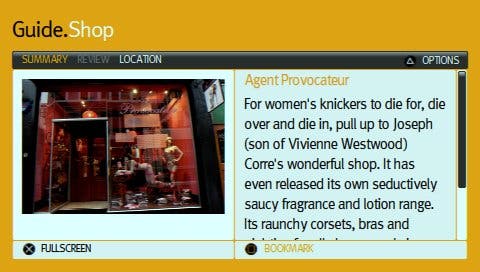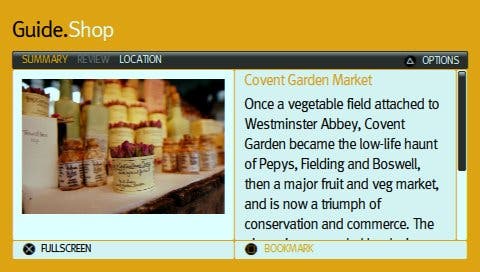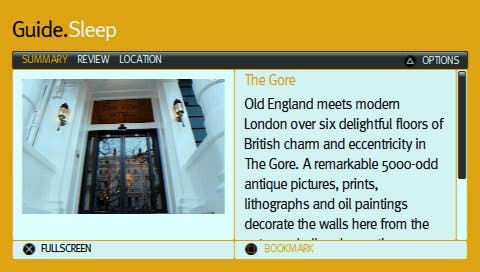Passport to London
Nowhere, man.
If Mayor Ken had his way, we would need a passport to London. The M25 would act as a giant metallic barrier to the outside world, built from a wall of endless rows of abandoned cars stacked twelve high. Meanwhile, Tony Blair would declare Greater London part of the United States and driving a car within the confines of the London Orbital would become the exclusive preserve of high-ranking politicians and royalty. The rest of us would sodding well use public transport and be grateful for its existence - but only if we use an Oyster card, wear an electronic tag and don't mind being occasionally blown up.
As any hardened London-based videogamer knows, urban living grants all manner of hidden benefits to spending endless hours of your life on hot, heaving buses and (even hotter) tube trains. Not only do you get to spend an inordinate amount of guilt-free time playing with handheld consoles while you travel, they're also a great way of killing time while you're waiting for lost and late friends to show up. Without public transport delays, my Virtua Tennis stats wouldn't be half as impressive.
But living in a vast, sprawling Metropolis is one thing - visiting it as a giddy, wide-eyed newbie tourist is quite another. Unless you're accompanied by a savvy local, the chances are you'll haplessly fall into every tourist trap imaginable. Arriving at Leicester Square, you'll watch the street performers, get the tube to Piccadilly Circus (gah!), dine at Planet Hollywood, kick the dirty winged vermin at Trafalgar Square, gawp at Big Ben, block every pavement you can find and feel like you've 'done' London. The trouble is, acquiring the knowledge takes years. Even after a solid decade of living here, London constantly surprises you with things you can't believe you never knew existed. As 'they' say, bored of London, bored of life.
Alone with everyone

All of which is a convoluted way of saying that Sony's interactive guide to the Big Smoke is an absolutely fantastic concept that fits the PSP perfectly. By teaming up with Lonely Planet, it gives tourists and clueless residents alike the chance to have an immense pocket information resource with them at all times. Whether you're looking for a specific place to stay, the key pubs to get lashed in or the most refined art haunts, Passport to London promises to make the whole experience a more interesting and pleasurable one.
And on a very basic level, there's no reason to suspect that the average visitor to the grand old English capital would have any issues with Sony's guide. It ticks most of the right boxes, is incredibly easy to navigate and should ensure that some of the very best that London has to offer becomes part of more people's itinerary - and even serves as a timely reminder to those of us that feel like we've seen all it as to offer.
Upon booting up Passport to London, you're greeted with a clean and simple menu system that makes it immediately clear what's on offer. Although there's no tutorial to guide you through the process, the menu navigation is so seamless and intuitive that it's really not necessary to be spoon-fed. Faced with the main headings, you get to choose from Guide, My London, Maps, Images, Videos, Audio Tour, Phrase Book, and Web. The 'hub' of the whole package centres around the Guide portion, which expands to include See, Shop, Eat, Entertainment, Sleep, and Essential Info. Then within those categories, for example, See includes Zoo, Historical Buildings, Architectural Highlights, Art Galleries, Monument, Museum, Religious/Spiritual, Royal, Significant, and Theatre/Cinema.
Wie komme ich am besten zum bahnhof?

By cycling left or right with the shoulder buttons, a few clicks later you'll be scanning through some of the best-known buildings to go and see, each with their own individual photograph, a brief text description (often with an additional review) and a scalable map to show you exactly where it is. If you like the look of it, you can then add it to your favourites, and even build your own itinerary based on where you plan to go during your stay.
With clear, definable categories, most of your curiosities will be sated, whether you fancy shopping 'til you drop, checking out the swankiest bars, eating in some of the more interesting restaurants around, clubbing until daybreak and shuffling off to your elegant hotel.
Beyond the Guide portion, My London simply serves as a basic run through of your bookmarks, the planner, and houses any of the promised downloads that Sony is planning to offer in due course. Maps offers all the basics you'll need, such as the Underground, Central London, Brixton and Clapham, Earl's Court and South Ken, Hyde Park and West London, as well as Islington and Shoreditch, and although the zoomed out versions prove to be largely unreadable, the two zoomed-in views will prove to be extremely useful when you're out and about and lost - although could have definitely have benefited from a search function to allow you to type in a street name.
Not from 'round here

In addition, the rather superfluous images section is a simple photo gallery of all the places listed in the Guide, while the Videos tab houses a few interesting but ultimately useless 'day in the life' montage clips from various cities around Europe, including Amsterdam, Paris, Prague and London itself. Meanwhile, the Audio Tours section looks promising until you realise that there are only actually three of them in the entire package (Shoreditch, South Bank and Hyde Park) - most disappointing, considering the epic scope of the project.
The Phrase Book, however, is a different story, with absolutely masses of essential queries addressed, translating stock English sentences into spoken audio samples of French, Italian, German Spanish, Dutch and Czech. Quite how useful this is to a foreign traveller to the UK is moot, but for an English traveller abroad it could be very helpful indeed - arming you with an enormous range of greetings and queries that deal with everything from everyday airport scenarios to emergency situations. And if you can't get the pronunciation right, you can always wave your PSP in the air and play the sound file.
But as much as Passport To London undoubtedly gets the basics right, the real problem with it is how appalling the attention to detail is, and worse still, how little detail it really carries. Within minutes the flaws and niggles jump out at you all over the place.
Entire categories of major cultural interest, such as live music and live sport are conspicuous by their absence, leading the weary traveller wondering how such fundamentals were deemed not a priority for this guide. That London's place as one of the most vibrant places to enjoy live entertainment on the entire face of the planet was overlooked is unforgivable, and doesn't bode well for the quality of the rest of the guide.
Written off

Even the stuff that is included is generally light on content too (how hard can it be to add text to a product like this? surely that's the whole point of it?), with bars, venues and restaurants given cursory overviews and uninformative, drab opinions that leave the reader none the wiser. Having been to many of the place listed myself, there's the sense that they've somehow missed the essence, and given exceptionally brief details - check out the muttering nonsense about the doormen at 93 Feet East and it sounds like it was written by an intern who popped by once.
The most maddening thing about the Passport to London is its mystifying selection procedure. You'll question why only four pubs were deemed worthy of inclusion (surely some sort of joke), why only one theatre made it in, why only a handful of indie cinemas were mentioned (and not, say, the giant famous ones in Leicester Square), and wonder how such a restaurant-obsessed city can have so few listed. Even the most cursory glance reveals absolutely stunning omissions - try and find the world famous Nobu Japanese restaurant and you'll draw a blank. Scour for the massive HMV in the music section and puzzle over why it's not there, or laugh out loud as the Oxford Street Virgin Megastore mentioned is illustrated by a photograph of the Piccadilly Circus branch. It's so slapdash it's insulting, and it simply gets worse the more you delve into the detail - or lack of therein.
Some of the more general essential information offers some sound advice, but there's the lingering sense that so much more could have been done to make this an essential travel companion for the millions of tourists pouring into the UK's capital on a daily basis. As it is, it comes across as a rushed attempt at providing something different for the PSP, and while Sony deserves applause for providing something genuinely unique for its handheld, it must realise that this is far from the definitive article for those venturing into London for the first time.
Of mockeries and shams
The tie-in with Lonely Planet might give Passport to London the badge of authenticity that sells units, but a far better idea would have been to hook up with the far superior ViewLondon website - a portal so chock full of everything you could possibly want to know about London that it makes a mockery of this lazy and shambolic effort. While Sony has a few solid ideas and a reasonable, basic interface, the content comes across like it was knocked up in a week by people with only a cursory knowledge of London. If Sony really wanted to make full use of the PSP, it would also build in things like online booking into the package and make it something so useful that people would be blown away by it. As it stands, it's a pretty pointless exercise in offering mid-90s-style interactive content on the PSP. A missed opportunity.

